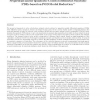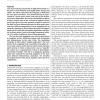59 search results - page 4 / 12 » A reduction approach to the repeated assignment problem |
AUTOMATICA
2011
13 years 3 months ago
2011
We present a framework to solve a finite-time optimal control problem for parabolic partial differential equations (PDEs) with diffusivity-interior actuators, which is motivate...
ICCAD
2005
IEEE
14 years 5 months ago
2005
IEEE
— Although the LUT (look-up table) size of FPGAs has been optimized for general applications, complicated designs may contain a large number of cascaded LUTs between flip-flops...
CACM
2010
13 years 8 months ago
2010
Data represented geometrically in high-dimensional vector spaces can be found in many applications. Images and videos, are often represented by assigning a dimension for every pix...
ICCAD
2006
IEEE
14 years 5 months ago
2006
IEEE
Soft errors in logic are emerging as a significant reliability problem for VLSI designs. This paper presents novel circuit optimization techniques to mitigate soft error rates (SE...
DAC
2009
ACM
14 years 9 months ago
2009
ACM
Digital microfluidic biochips have emerged as a popular alternative for laboratory experiments. To make the biochip feasible for practical applications, pin-count reduction is a k...


